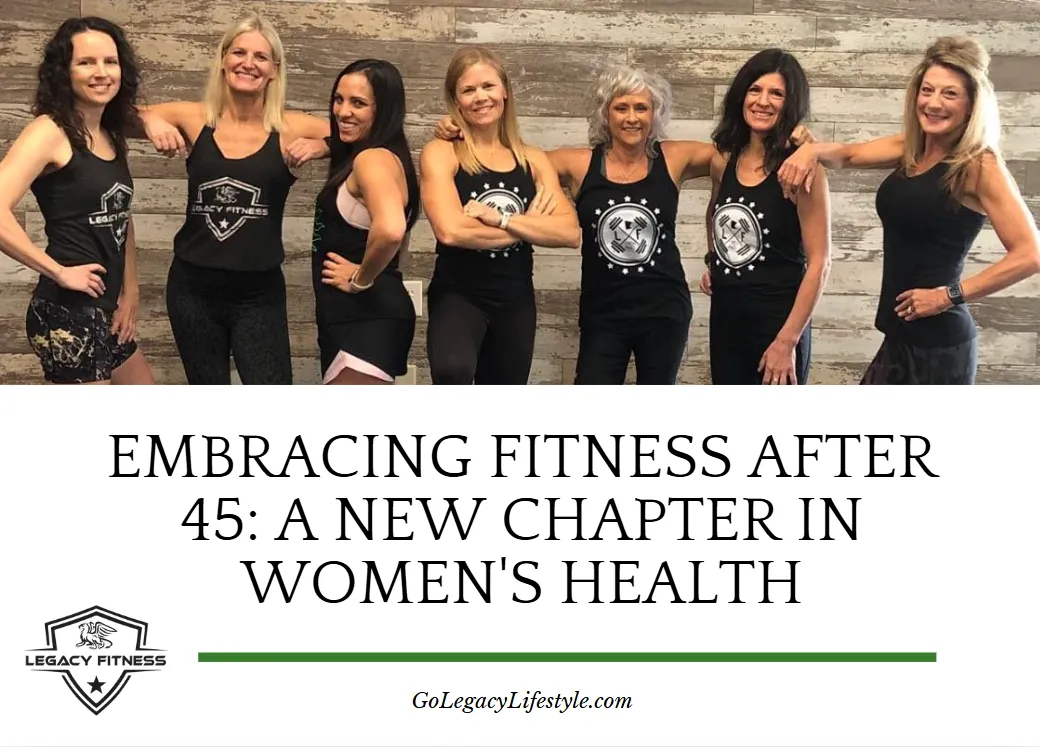Legacy Fitness Blog

Embracing Fitness After 45: A New Chapter in Women's Health
When I first started coaching women in their mid-40s and beyond at Legacy Fitness, I noticed a common thread in their stories. Many had been fitness enthusiasts their entire lives, following the same routines that had served them well for decades. Then suddenly, around age 45, everything changed. The scale wouldn't budge despite rigorous cardio sessions. Energy levels plummeted. Sleep became elusive. And those stubborn areas of fat seemed to appear overnight, particularly around the midsection.
If this sounds familiar, I want you to know something important: it's not your fault, and you're not alone.
The Biological Shift That Changes Everything
The transition that begins in perimenopause (often starting in the mid-40s) and continues through menopause represents one of the most significant biological shifts a woman's body experiences since puberty. Yet while we have extensive education about puberty, the conversation around menopause and fitness remains surprisingly limited.
As estrogen and progesterone begin their gradual decline, your body undergoes a cascade of changes that directly impact how you should approach fitness and nutrition. That metabolism that once allowed you to enjoy pasta dinners without consequence? It's naturally slowing down. The muscle mass that kept you feeling strong and toned? It's decreasing at a rate of approximately 3-5% per decade after age 30, with an acceleration after menopause.
Even your fat distribution changes, with a tendency to accumulate more around the abdomen rather than the hips and thighs. This isn't just a cosmetic concern—abdominal fat is associated with increased inflammation and higher risk for cardiovascular disease and type 2 diabetes.
Sarah, a 48-year-old Legacy Fitness member, described it perfectly: "It felt like my body had new rules, but nobody gave me the rulebook."
The New Rulebook for Fitness After 45
The good news? Once you understand these changes, you can adapt your approach to work with your body rather than against it. Here's what that new rulebook looks like:
Strength Training: Your New Best Friend
If you've spent years devoted to cardio machines thinking that's the path to staying slim, it's time for a paradigm shift. Strength training becomes non-negotiable after 45.
When Janet, 52, first joined Legacy Fitness, she was skeptical about lifting weights. "I was afraid of getting bulky," she admitted. Six months later, she had lost 18 pounds, gained noticeable muscle definition, and increased her bone density scores. "I wish someone had handed me dumbbells 20 years ago," she now says.
Strength training combats the natural muscle loss that occurs with aging (sarcopenia), which directly impacts your metabolism. Every pound of muscle burns approximately 6 calories per day at rest, while fat burns only 2 calories. Beyond the metabolic benefits, strength training also:
Stimulates bone formation, helping to prevent osteoporosis
Improves insulin sensitivity, making your body more efficient at processing carbohydrates
Enhances posture and reduces back pain
Increases functional strength for everyday activities
Boosts confidence and mental wellbeing
Aim for at least 2-3 strength sessions weekly, focusing on progressive overload—gradually increasing the weight or resistance as your strength improves. And don't be afraid to lift heavier weights! The myth that women will "bulk up" from strength training has been thoroughly debunked, especially for women over 45 who have naturally lower levels of testosterone.
The Protein Paradox
One of the most overlooked aspects of fitness after 45 is protein intake. As we age, our bodies become less efficient at protein synthesis—the process of building and maintaining muscle. Research suggests that while younger adults might thrive on 0.8g of protein per kg of body weight, women over 45 may need 1-1.2g per kg, especially when actively exercising.
This increased protein need comes precisely when many women find their appetites decreasing. It creates what I call the "protein paradox"—needing more protein while naturally wanting to eat less.
Carol, a 61-year-old member, transformed her body composition by simply increasing her protein intake from approximately 40g daily to 85g. "I wasn't hungry enough to eat that much protein naturally," she explained, "so I had to be strategic—adding protein to my morning coffee, keeping Greek yogurt handy for snacks, and ending my day with a small protein shake."
The results speak for themselves: improved muscle tone, better recovery between workouts, and reduced cravings for sugary foods.
Rethinking Recovery
In your 20s and 30s, you might have prided yourself on pushing through soreness, exercising daily, and wearing exhaustion as a badge of honor. After 45, this approach can backfire dramatically.
Recovery becomes as important as the workout itself. This means:
Allowing 48-72 hours between strength sessions for the same muscle groups
Prioritizing sleep hygiene, as sleep is when much of your hormonal regulation and muscle repair occurs
Incorporating active recovery days with gentle movement like walking, swimming, or yoga
Managing stress, which directly impacts cortisol levels and can contribute to abdominal fat storage
Diane, 56, found that switching from six high-intensity workouts weekly to three strength sessions, one HIIT workout, and two active recovery days actually accelerated her results. "I was doing less but getting more," she noted. "And I finally had the energy to enjoy my life outside the gym."
The Nutrition Revolution
Perhaps nowhere are the changes more dramatic than in nutrition needs after 45. The calorie-restrictive diets that might have worked (albeit temporarily) in your younger years can now exacerbate hormonal imbalances and accelerate muscle loss.
Instead of severe restriction, focus on:
Strategic carbohydrate timing: Consuming most of your carbohydrates around your workouts when your body can utilize them most efficiently for energy and recovery.
Anti-inflammatory eating: Emphasizing foods rich in omega-3 fatty acids, antioxidants, and fiber to combat the increased inflammation that often accompanies hormonal changes.
Blood sugar stabilization: Pairing carbohydrates with proteins and healthy fats to prevent the blood sugar spikes and crashes that become more common after 45.
Phytoestrogen-rich foods: Incorporating moderate amounts of foods like flaxseeds, soybeans, and legumes that contain natural plant compounds that may help ease the transition through hormonal changes.
Calcium and Vitamin D: Increasing intake of these nutrients critical for bone health, as bone density loss accelerates during and after menopause.
Michelle, 49, discovered that her previous low-carb diet was actually working against her. "When I started properly fueling around my workouts with carbs, and focused on protein and healthy fats at other meals, everything changed. My energy improved, my sleep got better, and the weight started coming off."
The Mind-Body Connection
Beyond the physical aspects, fitness after 45 has profound implications for mental and emotional well-being. Regular exercise has been shown to reduce the severity of menopausal symptoms like hot flashes, improve mood, and protect cognitive function.
Many of our members report that the mental benefits of their fitness routine outweigh even the physical transformations.
Your Next Chapter Starts Now
If you're feeling overwhelmed by all this information, you're not alone. That's exactly why our women's health expert, Coach Kim Madden, created "StrongHer by Design" - a comprehensive guide specifically for women over 45 who want to understand how to work with their changing bodies.
This free resource walks you through 7 essential steps to reset hormones, rebuild muscle, and reclaim your power during this new life chapter. From understanding the science behind your changing body to practical strategies for nutrition, strength training, and recovery, this guide distills decades of experience working with women just like you.
At Legacy Fitness, we believe that your best years aren't behind you—they're just beginning. With the right approach to fitness and nutrition, women over 45 can experience levels of strength, energy, and confidence they never thought possible.
The path forward isn't about fighting against your changing body—it's about understanding it and working with it. When you do that, transformation happens. Not just physical transformation, but a profound shift in how you feel moving through the world every day.
Ready to begin? You can download our free guide "StrongHer by Design" and take the first step toward fitness that works for your body now. Because this chapter of your life deserves its own rulebook—one written specifically for you.
Schedule an Intro Call to claim your FREE trial today and let us help you create a customized nutrition plan that fuels your fitness journey. Our coaches will help you create a manageable plan that you’ll actually want to stick with—so you can feel stronger, more confident, and fully capable of embracing everything life has to offer.


